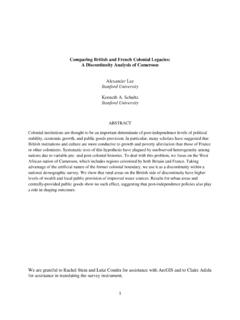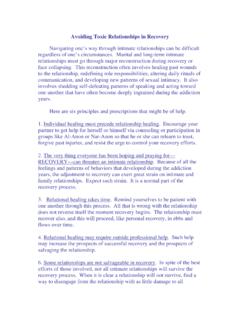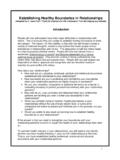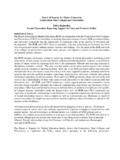Transcription of Evolution and ClosE RElationships - Social Sciences
1 3 Handbook of Personality and Social Psychology: Vol. 3. Interpersonal Relations, M. Mikulincer and P. R. Shaver (Editors-in-Chief)Copyright 2015 by the American Psychological Association. All rights a p t e r 1 Evolution and ClosE RElationshipsVladas Griskevicius, Martie G. Haselton, and Joshua M. AckermanThroughout history, humans have faced critical chal-lenges that included finding a mate, keeping that mate, caring for kin, forming coalitions, and gaining some status. Solving each of these ancestral chal-lenges involved forming a different type of Social rela-tionship. An evolutionary perspective suggests that there is a set of fundamentally different types of ClosE RElationships associated with different evolutionary challenges. These types include (a) mate attraction ( , dating couples), (b) mate retention ( , mar-ried couples), (c) kin care ( , family members), (d) coalition formation ( , friends), and (e) status ( , workplace RElationships ).
2 Each type of ancestral challenge is associated with different kinds of evolu-tionary opportunities and costs, suggesting that dif-ferent types of RElationships may be governed by a different relationship -specific psychology. In this chapter, we review the principles of evolutionary psy-chology and their implications for ClosE some animals spend most of their lives as hermits, humans have always lived in groups. The human brain has evolved for Social RElationships (Kenrick, Griskevicius, Neuberg, & Schaller, 2010; Kenrick, Neuberg, & White, in press). But although people are born ready to love and relate to other people, RElationships differ in several important ways. For example, the words I love you can be spo-ken by a parent to a newborn baby, by a young man to a woman he met yesterday at a beach resort in Mexico, and by a heterosexual woman to her best female friend.
3 Yet parental love is not the same as romantic love, which is still different from platonic love between this chapter, we consider Social RElationships from an evolutionary perspective. This perspective contends that, throughout history, humans have faced a set of core ancestral challenges, which include attracting a mate, keeping that mate, caring for kin, forming coalitions, and attaining status. An evolutionary perspective suggests that each type of challenge can be solved by forming different types of RElationships . These relationship types include (a) dating couples, (b) married couples, (c) family mem-bers, (d) friends, and (e) coworkers (see Table ). Each type of relationship is associated with different kinds of evolutionary opportunities and costs, meaning that people need different things from different types of intimate others and must provide different things to those intimate others.
4 These needs and provisions vary systematically depending on the type of this chapter, we first briefly review what it means to take an evolutionary perspective, review-ing some foundational principles. We then discuss each of the five types of RElationships , reviewing relevant theory and findings. Finally, we discuss emerging themes and future directions in the study of Social RElationships from an evolutionary EVOLUTIONARY APPROACH TO RELATIONSHIPSA modern evolutionary approach is based on the seminal work of Charles Darwin. This approach sug-gests that, just as the forces of natural selection can 307/01/14 4:19 PMUNCORRECTED PROOFS AMERICAN PSYCHOLOGICAL ASSOCIATIONG riskevicius, Haselton, and Ackerman4shape morphological features, so too can those forces shape psychological and behavioral tenden-cies.
5 An evolutionary approach maintains that human and nonhuman animals inherit brains and bodies equipped to behave in ways that are fitted to the demands of the environments within which their ancestors evolved. Just as human morphological features opposable thumbs, larynxes, and upright postures have been shaped by evolutionary pressures, humans inherited brains specially designed to solve recurrent problems in the ances-tral world (Barrett, Dunbar, & Lycett, 2002; Buss, 1995; Neuberg, Kenrick, & Schaller, 2010; Tooby & Cosmides, 1992). For example, along with the larynx, humans also inherited a brain designed to easily learn to communicate using language. Although the specific words and sounds of a language might differ across cultures, all languages share an underlying TAbLE Types and Associated Evolutionary Opportunities and ThreatsRelationship domainTypical dyadsRelationship tasksKey evolutionary theoriesRelationship opportunitiesRelationship threatsRelationship-specific sensitivitiesMate attractionDating coupleAttract desirable romantic partnerIntersexual selection, parental investment, strategic pluralism, sexual strategiesSexual and reproductive access, resource accessAbandonment after pregnancy, sexually transmitted diseases, partner deceptionSensitivity to partner s mate value, sexual strategy, honest costly signaling.
6 Other mating opportunitiesMate retentionMarried couplePreserve alliance with romantic partnerAttachment theory, strategic interference theoryLong-term parental alliance, instrumental and emotional supportSexual infidelity, resource infidelity, cuckoldrySensitivity to partner s change in relative mate value, cues to infidelity, mate poaching, infertility, mating ecologyKin careParent child, siblingsSuccessfully raise children and care for relativesKin selection, parent offspring conflictInclusive fitness, account-free resource sharing, cooperative breedingHigh costs of ClosE kin, parasitism of kinship, inbreedingSensitivity to kin member s relatedness, age, sex, ability, need, health, and other cues to enhancing inclusive fitnessCoalitionFriends, teammatesDevelop and maintain cooperative alliancesReciprocal altruism, Social contract theory, intergroup conflictShared resources, material support, instrumental support, protectionFree-riding cheaters, excessive demands, Social rejection, stigmatizationSensitivity to equity and unfair exchanges, trustworthiness, rejection, competence, group powerStatusWorker boss, coworkersGain and maintain Social prestige and powerIntrasexual selection, dominance hierarchyReputation-enhancing alliances, moving up status hierarchiesLoss of reputation, respect, and powerSensitivity to position in hierarchies, leadership cues in others, other status 407/01/14 4.
7 19 PMUNCORRECTED PROOFS AMERICAN PSYCHOLOGICAL ASSOCIATIONE volution and ClosE Relationships5universal structure as a result of the evolved human mechanisms for language (Pinker, 1994). Next, we review two key distinguishing features of a modern evolutionary Mind Evolved to Solve Adaptive Problems of the Ancestral PastAn evolutionary approach does not assume that humans or other organisms inherit the capacity to determine in advance which behaviors will enhance fitness. People do not proceed through life deliberat-ing the reproductive consequences of each decision. Instead, natural selection, operating over millennia, endows individuals with a psychology designed to increase the probability of solving recurrent adap-tive challenges. All of our ancestors confronted a set of problems that had to be solved to survive and reproduce, such as making friends, gaining status, attracting a mate, keeping a mate, and caring for family.
8 The brain is designed to solve adaptive chal-lenges, whereby the cumulative solutions to these challenges together enhanced fitness over Evolution -ary the modern environment is in many ways different from ancestral environments, humans still encounter problems the brain is designed to solve. Each problem has always been uniquely dif-ferent. Solutions to one problem failed to success-fully solve other problems. For example, solutions to the adaptive problems of attracting a mate ( , approaching genetically fit individuals) generally could not be used as solutions to the adaptive prob-lem of gaining status ( , approaching people with power or prestige). Because different evolutionary problems required qualitatively different solutions, an evolutionary psychological perspective suggests that the brain houses multiple domain-specific psychological mechanisms geared toward solving different adaptive problems (Barrett & Kurzban, 2006; Tooby & Cosmides, 1992).
9 The domain-specific view of the mind is impor-tantly different from the domain-general view that dominated the Social Sciences in the 20th century. This traditional view posits that the brain has a single executive system operating according to a few domain-general rules such as seek rewards, avoid punishments, or maximize utility. Such views initially appeal to parsimony, but an abundance of research on learning and cognition in both animals and humans challenged views of the brain that are completely domain general. Zoologists, biologists, and ecologists have uncovered a wealth of special-ized behavioral and cognitive mechanisms in ani-mals peculiarly suited to solving different types of adaptive challenges (Garcia & Koelling, 1966; Wilcoxon, Dragoin, & Kral, 1971). For example, birds use distinct, domain-specific neuropsychological systems for learning and remembering information about species songs, poisonous foods, and spatial position of food caches (Sherry & Schachter, 1987).
10 Similarly, humans use distinct, domain-specific systems and neural architectures for dealing with different types of adaptive problems (Barrett & Kurzban, 2006; S. B. Klein, Cosmides, Tooby, & Chance, 2002). Thus, because different types of Social RElationships helped to solve fundamentally different types of adaptive challenges, an Evolution -ary perspective posits that different types of Social RElationships function according to different rules in the ancestral past and Levels of Explanation for behaviorAn evolutionary perspective draws an important distinction between ultimate and proximate expla-nations for behavior (see Tinbergen, 1963). Psychol-ogists have typically been concerned with proximate explanations for behavior, which focus on the rela-tively immediate triggers (causes) of action.
















